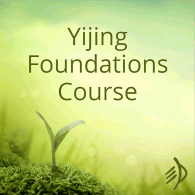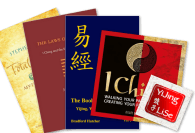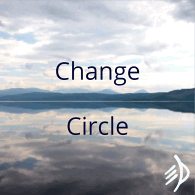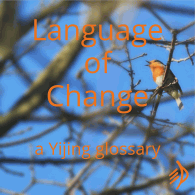Confusion…
Hexagram 8’s called bi, Seeking Union or Belonging (or Union, Alliance, Grouping, Joining, Holding Together, Closeness…)
And Hexagram 13 is tong ren, People in Harmony (or Fellowship, Cooperation, Community, Union of Men…)
According to the dictionary, we have one hexagram name that means (amongst other things) ‘to share with, join, coincide with, similarity, likeness…’ and another that means ‘bring together, compare, align with, collaborate, accord with, agree…’. Looking in the dictionaries that concentrate on the earliest meanings, both include ‘ally with’ among their meanings.
Then there are commentators who’ll tell you that both are about coming together, friendship, community, collaboration and building alliances. Hexagram 8, Seeking Union, can also mean the development of an inner agreement, as you learn to co-ordinate your own inner world… and so too can Hexagram 13. And finally, each hexagram has its own associated mythical/legendary story, both of which are about a great gathering and alliance at the inauguration of a new dynasty.
So what is the difference between Hexagram 8, Seeking Union/ Belonging, and Hexagram 13, People in Harmony?
Revisiting the dictionary
While there’s certainly some overlap in the meanings of bi and tong, there are some helpful distinctions, too. Bi, the name of Hexagram 8, specifically means comparison or analogy: metaphor, the comparison we use so as to relate to something and understand it better. Tong, on the other hand, is used as a verb to mean unifying things or making them uniform – musical pitches, for instance, or weights and measures.
Tong is very much about harmony and unanimity. There’s a revealing passage in the Book of History, on the examination of doubts:
‘If you have doubts about any great matter, consult with your own heart; consult with your nobles and officers; consult with the masses of the people; consult the tortoise and milfoil. If you, the tortoise, the milfoil, the nobles and officers and the common people all consent to a course, this is what is called a great concord, and the result will be the welfare of your person and good fortune to your descendants.’
(Legge translation)
The ‘concord’ in ‘great concord’ is tong: all these disparate and unrelated sources, from oracles to the man in the street, in harmony.
So it seems to me that while both hexagrams might result in an alliance, each would arise in a different way. Hexagram 8 would be finding or choosing connections and allies, while 13 would be hard at work creating them. Certainly that’s been my experience with Hexagram 13: less often ‘people are in harmony’, more often ‘time to think about bringing people into harmony’.
Oracles
‘Seeking union, good fortune.
At the origin of oracle consultation,
From the source, ever-flowing constancy.
No mistake.
Realms not at peace are coming.
For the latecomer, pitfall.’Oracle of Hexagram 8
‘People in harmony in the wilds: creating success.
Fruitful to cross the great river.
A noble one’s constancy bears fruit.’Oracle of Hexagram 13
I’ve written about the inner logic of Hexagram 8’s Oracle before – and about 13. Putting the two next to one another like this, I mostly notice the difference between their omens. Hexagram 8: good fortune, pitfall. Hexagram 13: crossing the great river, and the noble one’s constancy, are fruitful. One is about what’s lucky or unlucky, one is about what actions will bear fruit.
In Hexagram 8 you have a straightforward contrast: those who seek to join have good fortune; the latecomers don’t. (The fact that good fortune comes at the beginning of the text and ‘pitfall’ at the very end tells the story plainly.) Find your source, join the flow, and you can’t go wrong – really, all that’s asked of you here is to join promptly, sincerely, without hesitation. But Hexagram 13 is heng (‘creating success’), creative work, requiring that you go across the river, against the current and out of the comfort zone, creating momentum with your own efforts.
Stories
Both of these hexagrams have (probable) allusions to an ancient story of gathering allies. Hexagram 8 has Yu’s gathering after the conquest of the floods –
Those lines about the restless ones who come, and the pitfall for the latecomer, allude to the story of Yu the Great. After decades of hard toil, he had conquered the floods, and he called the lords and spirits together to found a new world. The character translated ‘on all sides’ is Fang, and it was Fang Feng who came late to Yu’s gathering and was executed. (More on that here.)
Hexagram 13 has Wu’s gathering of Zhou allies in the Wilds of Mu, before they crossed the river for the decisive battle against the Shang.
So one story is set just after the heroic effort, and one is before, but both are about to found a dynasty.
The differences are striking, though, aren’t they? Yu the Great is very much a mythic figure, and his work seems to me at once simpler and more mystical: redirecting the flow of the waters, dealing with monsters, casting the vessels, creating the group. Wu is a historical king, and his story is legend rather than myth. Yu draws the lords and spirits to him and executes the latecomer; Wu’s gathering is the culmination of a multi-generational work of building alliances. Yu was directly chosen by heaven to deal with the floods; Wu had to watch the skies to learn when the Mandate was his.
And the stories carry very different messages in readings. At Yu’s gathering, you need to opt in, to ensure you are on the inside. You can compare, find the best fit, follow your natural affinities and what flows together of its own accord. Hexagram 13’s message is almost the opposite: its first step is out into the wilds and across the river, outside your own group. You need to develop your awareness of the differences between people so you can forge alliances anyway.
Trigram pictures
These two hexagrams are formed from opposite trigrams: earth and water make Seeking Union –
heaven and fire make People in Harmony –
Hexagram 8’s trigrams are the perfect reflection of Yu’s completed task: now the rivers are flowing in their courses, over the earth.
‘Above earth is the stream. Seeking Union.
The ancient kings founded countless cities for relationships with all the feudal lords.’
This Image has always reminded me that cities are often founded along rivers, to take advantage of these natural connections. The ancient kings’ work involves fostering relationships by going along with the natural flow.
And Hexagram 13’s trigrams also reflect the story. The Zhou people must watch (li) the skies above (qian) to receive the mandate to act. (This is the very first appearance of the trigram li – fire, light and awareness – in the Sequence, emphasising that this is an ‘eye opening’ moment.) They will become People in Harmony with one another and with the Mandate of Heaven – a ‘Great Concord’!
‘Heaven joins with fire. People in harmony.
IIn the same way, the noble one sorts the clans and differentiates between beings.’
Instead of following natural connections, Hexagram 13’s noble one needs to trace out natural differences.
A few moving lines
What’s the ‘view’ like from the same line in each hexagram? Just a few…
Line 2
‘Seeking union’s origin, inside.
Constancy, good fortune.’
Seeking union from the inside is good – this is exactly the right way to go about it. This recalls the opening of Hexagram 8’s Oracle:
‘Seeking union, good fortune.
At the origin of oracle consultation,
From the source, ever-flowing constancy.’
Admittedly, the Chinese word translated ‘origin’ isn’t the same, but still… It seems to me to echo the same idea: coming from the source works best, because you can be guided by natural feeling.
13 line 2 is also ‘inside’:
‘People in harmony at the ancestral temple.
Shame.’
What could be more inside than the ancestral temple, where we are connected to our spiritual source? But this is a shameful place for people to find harmony. How come?
Commentators have many things to say about this; the text has none at all. The explanation I’ve found most helpful is that this is too inward-looking, too parochial. If we’re fixated on finding perfect unanimity, ‘my kind of people’, we can end up ignoring the existence of all the other kinds of people – and also sometimes asking too much of the in-group, when we should be looking further afield for support. This isn’t a disaster, but it’s not the best we could do.
Line 4
Line 2 is the inner centre; line 4 has just emerged into the outer trigram. So here are two ‘outside’ lines:
‘Outside, seeking union.
Constancy, good fortune.’
‘Climbed to the top of your city walls,
No one is capable of attack.
Good fortune.’
A favourable position for both hexagrams – but while Hexagram 8 is still seeking union, Hexagram 13 has to think about defense. 8.4 changes to Hexagram 45, Gathering: seeking union outside is in search of a bigger group and larger goals. 13.4 changes to 37, People in the Home, and the priority here is to develop healthy boundaries. If I’m up on the top of the walls, no-one can attack me, and also I’m not attacking anyone. Good city walls make good, harmonious neighbours.
Line 5
Line 5 is the place for choice, autonomy – normally the highest expression of a hexagram. 8.5 even says specifically that this is a ‘demonstration of seeking union’ – how it shines out, how it becomes manifest.
‘A demonstration of seeking union:
The king uses three beaters,
Lets the game in front go.
The city people are not coerced.
Good fortune.’
This is one of Yi’s illustrative vignettes. When the king goes hunting, he’s surrounded by beaters to drive the game towards him. (It would be a bad omen were he to come home empty-handed, after all.) But this king has beaters on only three sides, leaving one side open. And in the same way, he does not force people to obey him. Only those who want to follow him will come – as all the yin lines of Hexagram 8 are drawn to this one yang line.
‘People in harmony first cry out and weep, and then they laugh.
Great leaders can bring them together.’
Harmony between people doesn’t just flow into being by itself, and so the leaders of Hexagram 13 have work to do. They bring people together, creating mutual recognition (this line changes to Hexagram 30, Clarity) despite differences. Plainly there is friction and emotions are running high: the people cry out and weep before they laugh, and only great leaders are capable of bringing them together.
Imaginary readings
And finally…
This is always an intriguing way to explore readings – ‘What if Yi had answered with the paired hexagram instead?’ – it turns out that ‘thought experiment’ imaginary readings are quite a good way to explore differences between hexagrams, too…
‘How to find work?’
Hexagram 13, People in Harmony. Network! And go outside your comfort zone when you do; don’t just look for a carbon copy of your old job. Connect with new people and look for ways you could collaborate and your skills could be of service in new fields.
Hexagram 8, Seeking Union. Ask yourself what you are looking for in a job, what would bring you joy, and follow that. That job listing you saw that seemed to be calling your name? Apply for it now. Networking? Of course, but tracing friendship connections to meet kindred spirits might be more valuable than LinkedIn.
‘What to expect in this relationship?’
Hexagram 13, People in Harmony. Friendship, support, an ally, something to stretch you. It doesn’t feel particularly romantic.
Hexagram 8, Seeking Union. A kindred spirit, easy natural attraction – provided you aren’t too slow to commit yourself. (Alternatively, maybe especially if Hexagram 8 were unchanging – they’re not already in a relationship, are they?)
‘How to treat this minor ailment?’
This isn’t a wholly imaginary reading, as I’ve received Hexagram 13 in response to this one. It was one of those injuries you treat at home while thinking, ‘If this doesn’t get better, I suppose I should see a doctor’. With Hexagram 13, I brought together all the different natural (collaborative!) remedies I knew of, and everything was fine within hours. I’m not so sure what I would have done if I’d cast Hexagram 8 instead – perhaps consulted my intuition as to what treatment felt right, and used it promptly? Or the final line of the oracle might have made me nervous enough to see a doctor without the ‘wait and see’.
I hope all this helps with some real readings…










Dear Hillary,
I hope my English improved somewhat :). I love the elaborations on “bi” and “tong ren”, their different ways of bringing things together kept on being somewhat mysterious for me and many others. Though I never gave it coherent thought, I do have some additional insights.
In hex 8, bi, it is about sympathy. The simpel fact of sharing food, having a party together, sharing good music, having a good time together en enjoying together. It is one yang, an authority, that brings al the yin together. The idea, the reason for sharing comes from that authority, a person.
in hex13, tong ren, it is about teachings, spiritual ideas, that bring people together, all very yang indeed. The moment those teachings are associated with a group, person, clan, family, they loose there universality. Then you get those who are initiated, and the outsiders, as expressed in the only yin from line 2. In-group and out-group, and the boundaries that are made from gossip and ritual. Of course this runs directly against the idea of ‘tong ren’. At the same time, you need a safe group to spread teachings…. Anyway, the result can be a clique, or a sect. Line 3 is checking out all the time if the other is talking and behaving according the teachings, and “shoots” when the other is trespassing the lines of the teachings. Als line 4 is taking the moral high ground.
In German sociology you have a distinction between “Gemeinschaft” and “Gesellschaft”. Gemeinschaft is associated with hex 8 (I think), Gesellschaft with hex 13. How to translate those concepts in English… Sympathy and Harmony? Closeness and Fellowship?
hoping I contributed, cordiallement, bert dalmolen
Hello Bert,
Good thoughts, thanks! Gemeinschaft – community, maybe ‘togetherness’, ‘fellowship’? And Gesellschaft – society, but then it also means a corporation, so it feels a lot less personal.